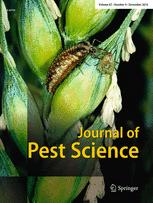Ver ítem
- xmlui.general.dspace_homeCentros Regionales y EEAsCentro Regional Patagonia NorteEEA BarilocheArtículos científicosxmlui.ArtifactBrowser.ItemViewer.trail
- Inicio
- Centros Regionales y EEAs
- Centro Regional Patagonia Norte
- EEA Bariloche
- Artículos científicos
- Ver ítem
Can entomophagous nematodes slow the spread of invasive pest populations? The case study of Beddingia siricidicola released for the management of Sirex noctilio
Resumen
Though rarely used in this way, biological control could potentially be exploited for managing spread of invasive species. Because spread of invasive species emerges from the combined action of population growth and dispersal, natural enemies that affect either of these processes should also affect spread. Dispersal of parasitoid species plays a key role in determining their impact on population growth of an invading host species along their expanding
[ver mas...]
Though rarely used in this way, biological control could potentially be exploited for managing spread of invasive species. Because spread of invasive species emerges from the combined action of population growth and dispersal, natural enemies that affect either of these processes should also affect spread. Dispersal of parasitoid species plays a key role in determining their impact on population growth of an invading host species along their expanding population front. In contrast, dispersal of most true parasites only occurs via movement of hosts so any impact that parasites may have on host dispersal may limit the parasite’s own capacity to keep up with an expanding host population. We test this premise by examining field data from what is probably the best example of the successful use of true parasites in biological control: the nematode Beddingia (=Deladenus) siricidicola, which is released for management of Sirex noctilio populations. We analyze the historical impact of nematode releases on the rate of spread of invasive S. noctilio populations in Southern Argentina. Our findings suggest that, nematode releases did not discernibly slow the spread of S. noctilio populations. We conclude that although entomophagous parasites could be effective at reducing the growth and dispersal of localized host populations, they are unlikely, unless widely released through the leading edges, to slow the spread of invading hosts
[Cerrar]

Autor
Corley, Juan Carlos;
Villacide, Jose Maria;
Liebhold, Andrew M.;
Fuente
Journal of pest science 87 (4) : 551–557. (December 2014)
Fecha
2014-12
ISSN
1612-4758 (Print)
1612-4766 (Online)
1612-4766 (Online)
Formato
pdf
Tipo de documento
artículo
Palabras Claves
Derechos de acceso
Restringido
 Excepto donde se diga explicitamente, este item se publica bajo la siguiente descripción: Creative Commons Attribution-NonCommercial-ShareAlike 2.5 Unported (CC BY-NC-SA 2.5)
Excepto donde se diga explicitamente, este item se publica bajo la siguiente descripción: Creative Commons Attribution-NonCommercial-ShareAlike 2.5 Unported (CC BY-NC-SA 2.5)

